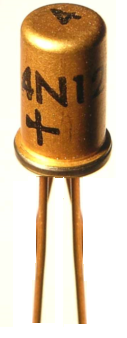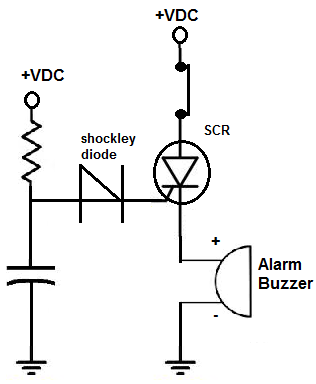What is a Shockley diode?

A shockley diode is a diode which is used primarily for switching applications.
Unlike other types of semiconductor diodes, the shockley diode has more than a single PN junction. Its construction includes
2 of each type of semiconductor in an alternating pattern. So, where a conventional diode can be described as PN, the shockley diode
will be described as PNPN. Because it is made up of four semiconductor sections, it is also known as the four-layer diode. It is the only
diode which is composed of 4 layers of semiconductor sections. However, like most other diodes, it has 2 terminals endings, which will make
connection to the circuit we are hooking it up to. So it still fits the definition of a diode, as a two-electrode deevice.

You can see in the above illustration the 4 layers which make up a shockley diode. The 2 electrodes, as in all diodes, are the
anode and the cathode. The anode receives the positive voltage, while the cathode connects to the negative voltage, or ground.
The shockley diode is used primarily for switching applications. It features switching properties similar to those of a lamp.
Each shockley diode has what is called an inhererent trigger voltage. When the diode receives a voltage across its terminal below the trigger voltage, the device is in its "off state" and the diode exhibits a very high resistance. But when the applied voltage exceeds the trigger value, the shockley diode will be switched on and the resistance will drop to an extremely low value. Typically, the on resistance of a diode is just a few ohms. This is significantly lower than the forward-biased resistance of most ordinary diodes.
The trigger voltage may be identified by any of several alternate names in various technical manuals and specification and datasheets.
It may be also called the threshold voltage, firing voltage, avalanche voltage, or breakover voltage. All of these are the same and is the voltage which is needed
to turn the switch the diode from off to on.
Shockley Diode Circuit
We will now go over a shockley diode circuit so you can get a feel as to how it is used.
Since shockley diodes are mostly used for switching applications, we will go over a circuit where it is used as a switch to turn on an SCR.
Shockley diodes are commonly used in circuits to turn on an SCR, which then can switch on something else.
The circuit is:

Here in this circuit, the shockley diode turns on the SCR, which then turns on the alarm and keeps it on until the power is disconnected.
The first part of the circuit is the RC part. This resistor-capacitor network is fed DC voltage. The capacitor will charge up through this resistor. Once the DC power is removed from this circuit, the capacitor will discharge through the shockley diode. This discharge will be above the shockley diode's trigger voltage and will switch the diode on. Once the shockley diode is switched on, it will switch the SCR on. And then the SCR switches on the alarm.
The cathode of the shockley diode must be connected to the SCR's gate. Once the SCR's gate receives sufficient voltage, it will conduct current across it from anode to cathode. An SCR is a latching switch. Once it receives sufficient voltage at its gate, it conducts current across its terminals unless all power is removed. Removing the gate current at this point has no effect. The current will still conduct from anode to cathode. Power must be removed from its anode. This is why SCRs are good for turning on devices that remain on until deactivated, such as alarm circuits. This is also the reason why a normally closed switch is placed on the anode side of the SCR. If you want to deactivate the buzzer, we must disconnect the power from the anode of the SCR. To do this, we place a normally closed SPST switch on this terminal.
For more information on SCRs, see What is a Silicon-controlled Rectifier?
You may even ask, what is the shockley diode even needed? Why not just remove it and only use the SCR? The reason is the shockley diode needs less current to switch on than the
SCR. Therefore, if current is limited in a circuit, a shockley diode an be used to switch on the SCR. Once the shockley diode is turned on by the SCR, its resistance drops
signifcantly. It creates a very low-resistance path for
current to travel through. Current then takes this path, once the diode is switched on, and is then great enough to switch on the SCR.
Note: The shockley diode is pretty much a primitive diode and is not greatly used today.
Related Resources
Types of Diodes
What is a Varactor?
What is a Protection Diode?
What is a Photodiode?
What is a Shottky Diode?
What is a Fast Recovery Diode?
What is a Zener Diode?
What is an Ideal Diode?
How to Test a Diode
How to Test a Zener Diode
